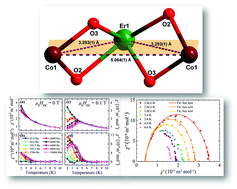Heterometallic trinuclear {Co III2LnIII} (Ln = Gd, Tb, Ho and Er) complexes in a bent geometry. Field-induced single-ion magnetic behavior of the ErIII and TbIII analogues†
Abstract
Through the use of a multi-site compartmental ligand, 2-methoxy-6-[{2-(2-hydroxyethylamino)ethylimino}methyl]phenol (LH3), the family of heterometallic, trinuclear complexes of the formula [CoIII2Ln(L)2(μ-O2CCH3)2(H2O)3]·NO3·xMeOH·yH2O has been expanded beyond Ln = DyIII to include GdIII (1), TbIII (2), HoIII (3) and ErIII (4) for 1, 3 and 4 (x = 1; y = 1) and for 2 (x = 0; y = 2). The metallic core of these complexes consists of a (CoIII–LnIII–CoIII) motif bridged in a bent geometry resulting in six-coordinated distorted CoIII octahedra and nine-coordinated LnIII monocapped square-antiprisms. The magnetic characterization of these compounds reveals the erbium and terbium analogues to display a field induced single-ion magnetic behavior similar to the dysprosium analogue but at lower temperatures. The energy barrier for the reversal of the magnetization of the CoIII2TbIII analogue is Ueff ≥ 15.6(4) K, while for the CoIII2ErIII analogue Ueff ≥ 9.9(8) K. The magnetic properties are discussed in terms of distortions of the 4f electron cloud.


 Please wait while we load your content...
Please wait while we load your content...